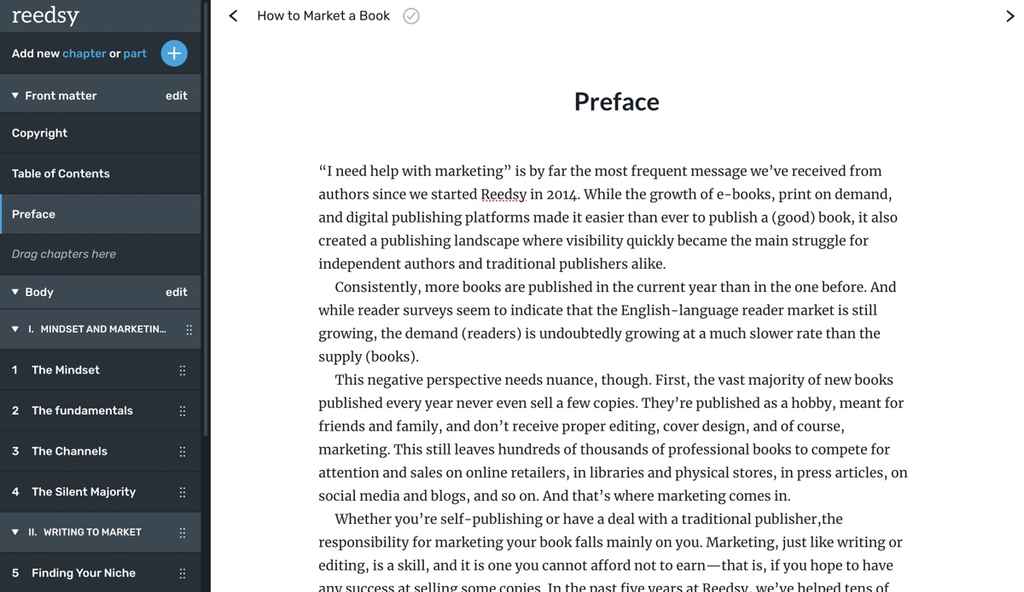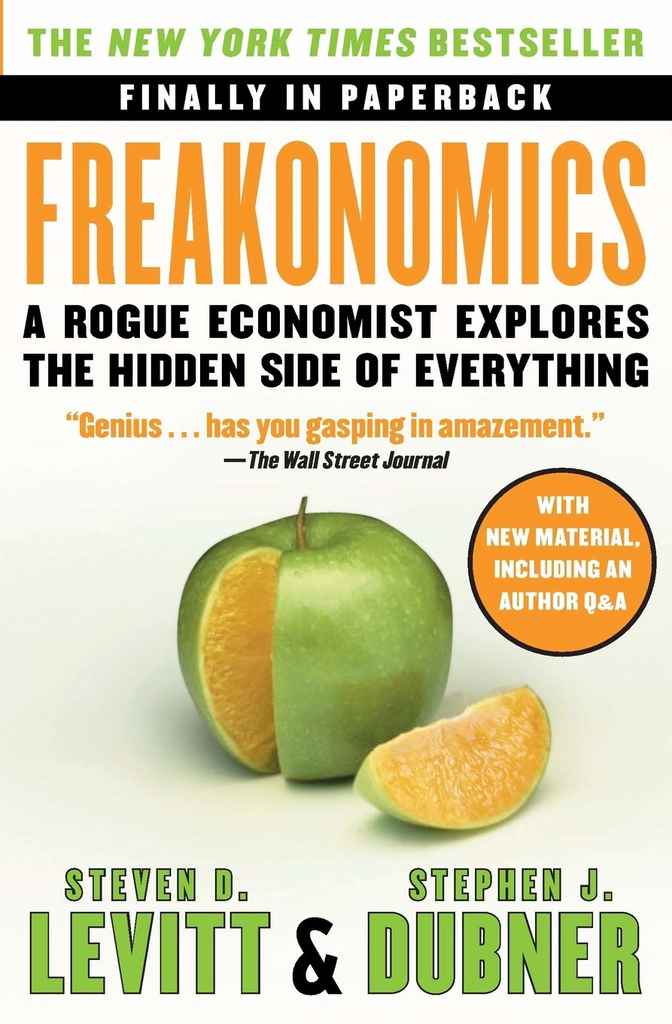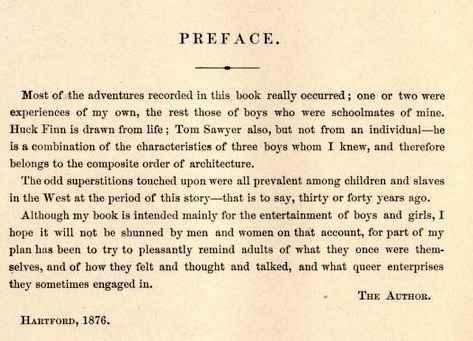Guides • Perfecting your Craft
Last updated on Aug 31, 2021
What is a Preface? Characteristics and Examples
Ricardo Fayet
Reedsy co-founder and Chief Marketing Officer, Ricardo Fayet has worked with hundreds of authors on their launches and marketing campaigns. He is the author of two bestselling guides on marketing for authors, and a regular presenter at the largest writers' conferences.
View profile →A preface is an introductory passage written about a book by its author. It lays out why the book exists, its subject matter, and its goals. Prefaces are more commonly found in nonfiction books, but they can also be used in fiction.
Because prefaces are part of a book’s front matter, they’re often confused with forewords and introductions. However, there are key differences among the three: a preface gives explanatory context for the book, while the introduction dives directly into the story, segueing smoothly into the body text. And while a preface or an introduction is typically written by the book’s author, a foreword is written by a separate person — usually an expert who lends the book credibility.

Now that we know what a preface is (and isn’t), let's break down what greater purposes they can serve in a book, along with some examples to demonstrate.
Gets the reader invested
A preface is an author’s chance to sell readers on their book. It should be written with the intent to draw readers in, rather than simply self-mythologize or over-egg a message that is already clearly conveyed in the book. Instead of boosting their own ego or spoon-feeding their message to readers, an author should aim to whet readers’ appetites with their preface.
To that end, a preface should give some irresistible insights into a book’s content. In nonfiction, this may be a brief mention of the book’s thesis and the areas it will cover, while in fiction, authors have a little more creative freedom to tempt their audience. Regardless of what’s in it exactly, your preface should do one thing above all: compel readers to keep turning the pages.

Example #1: Freakonomics by Steven Levitt and Stephen Dubner
Titled “An Explanatory Note,” the preface to this nonfiction phenomenon gives us a glimpse not only into the co-authors’ backgrounds but also into their relationship to one another. It recalls a meeting of the minds between the economist fascinated by “riddles of everyday life” and the journalist who was relieved to meet an academic with a talent for speaking in plain English. With the authors’ bona fides firmly established, this preface beautifully tees up what the reader can expect: genuine academic insight into economics, written plainly yet with passion.
💡 Give exclusive-yet-succinct insights to intrigue
Don’t go overboard in teasing what’s to come — this is a chance to show off your content and draw readers in, not to baby your audience through points that will become perfectly obvious in the course of your book. Aside from a brief description of the key figures (or main characters, if writing fiction) and core themes, leave the rest up to the book itself. Less is more!
And to differentiate your preface from, say, your blurb, make these insights sound like they’re actually coming from you (which they are!). You can do this not only by writing in your authorial voice but also by signposting your personal opinion. Discuss how excited you are for readers to meet a favorite figure/character, or to read a chapter you’re especially proud of. But again, don’t be too effusive — in terms of length, your preface should be 2-3 pages at most.
Explains why the book was written...
A preface is a perfect place to provide the rationale behind a book and what the author’s goal was in writing it. If they were driven by a specific purpose, or have something they hope their readers will learn from the book, this is their opportunity to share it.
The author might reveal what inspired them to write this book, how they came to care about the subject, or why they’re uniquely qualified to write about it. Knowing that the author has a passionate, personal connection to the subject can get readers excited — not to mention that sharing relevant credentials or experience will reassure them that they’re in safe hands.
Example #2: A Promised Land by Barack Obama
The preface to Barack Obama's latest memoir, A Promised Land, invites the reader to join him at the end of his presidential run. He reveals that he started writing the book on his last flight on Air Force One, driven by a need to record his time in office. But A Promised Land is more than a chronicle; Obama states that the greater reason for this book was to show what it’s actually like to be the president and to inspire others with his story of finding purpose in public service.

His preface provided such a strong introduction to the book that it was not only highly effective at enticing readers, but also worked as a standalone piece. The preface was widely excerpted and republished during the publicity push for A Promised Land — a lesson that a well-written preface can be an extremely useful weapon in your book’s marketing arsenal.
💡 Ground your book in a single lightbulb moment
Your readers don’t need to know about every single event leading up to your book. Rather, consider following in Obama’s footsteps and grounding your book in a particular moment of inspiration, as he had on Air Force One. Don’t waffle around about how you always wanted to write something — instead, pinpoint a meaningful, memorable moment for the story to begin.
...or reveals something about the author’s process
Again, your preface is your chance to tell your book’s story — and this can not only mean why, but also how it came to be. An author can use a preface to reveal behind-the-scenes info about the writing process that might pique readers’ interest.
Most important (and exciting for the reader!) is to share details of the writing journey itself. What challenges did you have to overcome as an author? How did your perspective evolve as you wrote the book? It’s important not to get too navel-gazey when explaining these aspects, but some vivid autobiographical details can really get readers invested in you and your work.
You might also include methodological matters in your nonfiction preface: how you conducted your research, why you took a particular approach, and the specific parameters of your book (i.e., why you’ve focused on this topic and what the limits of your knowledge are). It reassures readers that you’ve done your due diligence and shows you’re fully transparent.
💡 Add an author signature to seal this moment in time
The standard preface format includes a “signature” from the author, along with the date and time of writing. This is an excellent way to signal that you’re writing with hindsight: now that you’re at the end of your writing journey, you can reflect on how the book’s direction may have changed over time, and how your own life and emotions were affected while writing.
This slight temporal distance from your original work will not only make the preface feel more profound, but the specific date will also seal this particular moment in time — which could be fascinating for posterity.

Provides essential historical or social context
If certain details will add to the reader’s experience but don’t quite fit in the book itself, the preface is the place to share them. When the author wants to situate their story without explicitly doing so in the main text, they can use the preface to fill in any gaps.
With nonfiction, authors will often mention previous, relevant literature or research in their preface, placing the work in a wider academic or historical context. A preface also provides context to future readers — in case anything changes after you write the book, the preface can acknowledge that, while explaining how the original work is still valuable. And of course, if you as the author change your mind about something, you can re-issue your book with a preface explaining how your views have evolved or what you would do differently today.
That said, some authors forget that many readers will (unfortunately) breeze straight through the front matter — so if something is truly essential to a reader’s understanding, this isn’t the place for it. A preface is best viewed as bonus insight into a book, rather than a presentation of things you must know to understand it; information like that would be better labeled as an introduction.

Example #3: Catch and Kill by Ronan Farrow
Ronan Farrow’s journalistic true crime book, Catch and Kill, recounts the challenges the author faced while investigating powerful media predators like Harvey Weinstein, and the widespread industry corruption that allowed them to hide in plain sight for decades. As a result, new developments were coming out even as the book was going to press.
To make up for this, Farrow included a preface discussing developments in the story after the book was submitted to editors — a perfect example of a preface giving illuminating context which can’t fit neatly into the main narrative of the book.
💡 Highlight the book’s key influences
As well as historical, geographical, or social context, you can also reference literary context here. If you’re particularly indebted to or inspired by an author or literary tradition, mentioning it within your book’s preface lets prospective readers know what to expect and look out for.
One author who took this approach (bonus example alert!) was Virginia Woolf, who included a long list of literary “friends” in the preface of Orlando:
“Many friends have helped me in writing this book. Some are dead and so illustrious that I scarcely dare name them, yet no one can read or write without being perpetually in the debt of Defoe, Sir Thomas Browne, Sterne, Sir Walter Scott, Lord Macaulay, Emily Bronte, De Quincey, and Walter Pater, to name the first that come to mind. Others are alive, and though perhaps as illustrious in their own way, are less formidable for that very reason.”
It’s a nice way of placing your story within a canonical context, hinting at possible literary allusions your readers may find later in the book, and acknowledging the authors who paved the way for you. Note, however, that you can always save these kinds of acknowledgments for the back matter of your book.
If you do opt to include a preface, it’s these unassuming pages that will kick off your work. So no matter what you choose to include, make sure it starts with a bang — so that your book doesn’t continue on a whimper.
Speaking of which, let's continue on to the next section: the prologue!



2 responses
Sanni Adoki A. says:
25/08/2019 – 17:54
Good to read your article on Preface, Foreward and Introduction. It has helped me gain knowledge about the subject matter I have a plan to write a book (academic) which I dimmed it fit to include Introduction. However, at what point do I write the Introduction? Is it before writing the body of the book or after the body of book has been written. Thank you for the quick respond in anticipation
↪️ Martin Cavannagh replied:
27/08/2019 – 08:51
I think that a lot of people save writing the introduction until the body of the book is done. After all, you don't want to rewrite the intro if your book turns out differently to how you planned it :)